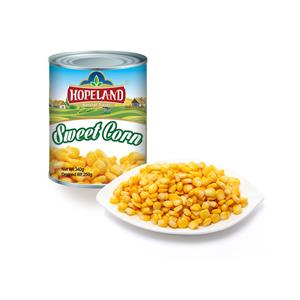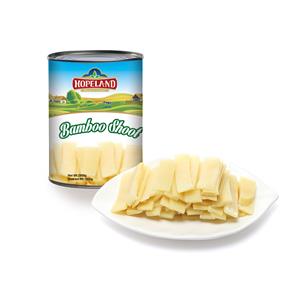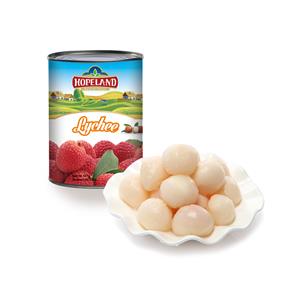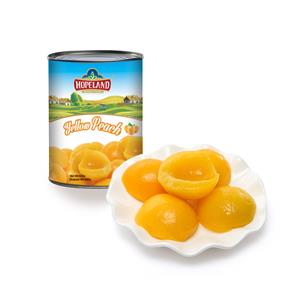Canned Baked Beans: Small Bean Vs. Big Bean
Introduction
When you open a can of baked beans, you’re not just uncovering a simple food item—you’re tapping into a long history of culinary tradition, comfort, and convenience. Baked beans, especially the canned variety, have been a staple on breakfast tables, camping trips, and quick weekday dinners for decades. They are rich in flavor, high in nutrients, and endlessly versatile.
Among the many kinds of baked beans available in the market, two types often draw attention: small beans and big beans. Each has its own texture, taste profile, and culinary appeal. Understanding their differences helps consumers and food producers alike to appreciate the subtle variations that make baked beans so beloved around the world.
This article delves deep into the world of canned baked beans—exploring how they are made, the nutritional value they offer, and how the size of the bean influences flavor, texture, and cooking versatility.
1. The Story Behind Baked Beans
Baked beans trace their origins to Native American cuisine, where indigenous tribes slow-cooked beans with maple syrup and animal fat. When European settlers arrived in North America, they adapted the recipe, substituting molasses and pork for the native ingredients. Over time, baked beans evolved into a hearty dish that became central to American and British comfort food traditions.
In the 19th century, as canning technology developed, baked beans became one of the first ready-to-eat canned foods. They gained immense popularity because they were affordable, shelf-stable, and nutritionally balanced—a convenient protein source during wartime and in busy households.
Today, baked beans are enjoyed worldwide, from English breakfasts to American barbecues, and from Asian fusion cuisine to vegetarian meal plans.
2. Small Beans vs. Big Beans: What’s the Difference?
The beans used in canned baked beans are typically from the Phaseolus genus—commonly navy beans, great northern beans, or haricot beans. However, depending on the brand and recipe, manufacturers may use small beans or big beans to achieve different textures and appearances.
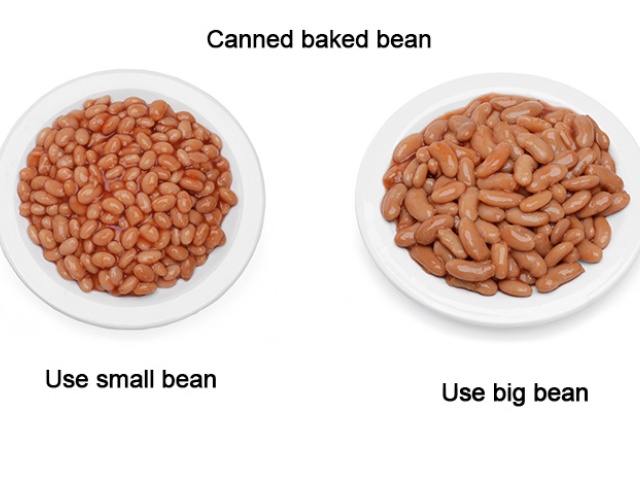
(a) Small Beans
Small beans, often called navy beans or pea beans, are tiny, oval, and white. Their delicate size makes them perfect for absorbing sauces and seasonings evenly. When cooked, they remain soft yet creamy, offering a smooth mouthfeel.
Characteristics of small beans:
Size: Small and oval, about 1 cm long
Texture: Tender and smooth
Flavor: Mild and slightly nutty
Cooking performance: Absorbs sauce flavors effectively, doesn’t break easily
Common use: Traditional canned baked beans (e.g., British-style beans in tomato sauce)
(b) Big Beans
Big beans, such as great northern beans or butter beans (lima beans), are larger and meatier. Their robust structure gives them a firmer bite and a richer, more substantial presence in dishes.
Characteristics of big beans:
Size: Larger and flatter than navy beans
Texture: Firm and hearty
Flavor: Earthier and slightly stronger
Cooking performance: Retains shape better, ideal for slow-cooked dishes or thick sauces
Common use: Premium baked bean varieties, mixed bean salads, and Mediterranean-style recipes
In short, small beans tend to blend seamlessly into sauces, creating a cohesive, creamy dish. Big beans, on the other hand, stand out visually and texturally, offering more bite and a more rustic eating experience.
3. The Art of Canning Baked Beans
Canning baked beans is both a science and an art. The process ensures that the beans remain flavorful, safe, and nutritious for months—or even years—without the need for preservatives.
Step 1: Bean Selection and Cleaning
Manufacturers begin by selecting high-quality dried beans. These beans are sorted by size, color, and density to ensure consistency. Foreign materials or damaged beans are removed through mechanical sorting and washing.
Step 2: Soaking and Blanching
The beans are soaked in water for several hours to rehydrate them. After soaking, they are briefly blanched in hot water to soften the outer skins and partially cook the beans.
Step 3: Preparing the Sauce
The signature baked bean flavor comes from its sauce—usually a mixture of tomato paste, sugar or molasses, salt, and spices like mustard or paprika. Some recipes include bacon or pork fat, though many modern versions are vegetarian or vegan-friendly.
Step 4: Filling and Sealing
The partially cooked beans are mixed with the sauce and filled into sterilized cans. These cans are then sealed under vacuum to prevent contamination.
Step 5: Heat Processing (Sterilization)
Finally, the sealed cans are heat-treated under high pressure (typically in a retort) to destroy bacteria and ensure shelf stability. This process also allows the flavors to meld beautifully, creating that signature baked bean taste.
The result is a ready-to-eat product that retains the natural taste and texture of beans while offering the convenience of long-term storage.
4. The Flavor Equation: How Bean Size Affects Taste
While the sauce plays a major role in baked beans’ overall flavor, the size of the beans contributes significantly to how the dish tastes and feels.
Small Beans – Subtle and Smooth
Small beans have more surface area relative to their volume, which means they absorb sauces quickly and thoroughly. This makes every bite consistent in flavor. The texture tends to be velvety, making small-bean baked beans ideal for spreading on toast or pairing with soft foods like scrambled eggs.
Big Beans – Bold and Distinct
Big beans offer a more layered eating experience. Since they absorb sauce more slowly, you can taste both the natural bean flavor and the sauce’s seasoning. They hold up well in stews, casseroles, and baked dishes where a stronger, chunkier texture is desired.
Ultimately, choosing between small and big beans is about personal preference:
Small beans = uniform taste, smoother texture
Big beans = distinct flavor, firm bite
5. Nutritional Benefits
Baked beans are not only delicious—they’re also packed with nutrients that make them an excellent addition to any diet.
Key Nutritional Highlights (per 100g):
Calories: 90–120 kcal
Protein: 4–6g
Fiber: 3–5g
Fat: 0.5–1g
Iron, magnesium, potassium, and B vitamins
High in Plant Protein
Beans are an affordable and sustainable protein source, making them a valuable choice for vegetarians and those reducing meat intake.
Rich in Fiber
Both small and big beans contain high levels of dietary fiber, promoting digestive health, lowering cholesterol, and helping maintain steady blood sugar levels.
Low in Fat
Canned baked beans are naturally low in fat, especially if prepared without added pork or animal fats.
Energy Sustaining
The combination of protein, complex carbohydrates, and fiber helps sustain energy throughout the day, making baked beans ideal for breakfast or post-workout meals.
6. Global Appeal of Baked Beans
Canned baked beans have transcended cultural boundaries. Although the base ingredients remain similar, each region adds its own twist.
United Kingdom: Classic small navy beans in a tangy tomato sauce—served on buttered toast, a national favorite.
United States: Larger beans baked with molasses, brown sugar, and sometimes bacon—sweet, smoky, and hearty.
Australia & New Zealand: British-style beans, often served with breakfast or on sandwiches.
Asia: Baked beans appear in fusion dishes like bean fried rice, baked bean curry, or even noodle stir-fries.
Mediterranean region: Large beans baked with olive oil, garlic, and herbs, reflecting Greek and Turkish culinary influences.
This global adaptability shows the baked bean’s versatility—it fits into breakfast, lunch, or dinner menus, both as a main and a side dish.
7. Creative Ways to Use Canned Baked Beans
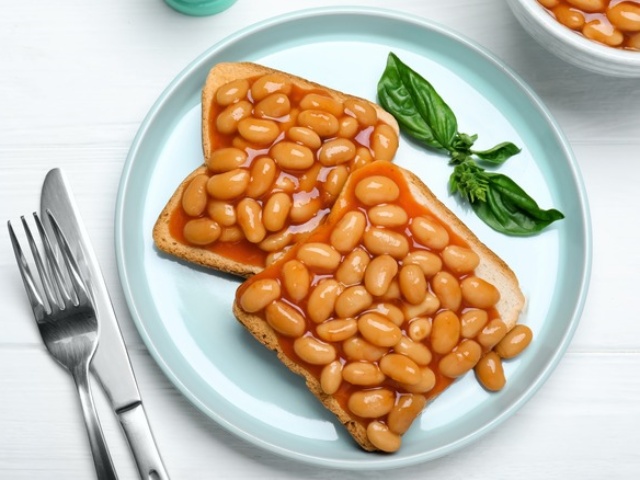
Canned baked beans, whether made from small or big beans, can elevate a wide variety of meals. Here are some creative serving ideas:
Classic Beans on Toast:
A timeless British comfort food—simple, filling, and ready in minutes.
Hearty Bean Stew:
Combine big-bean baked beans with vegetables and sausage for a rich, warming stew.
Bean Chili:
Add small baked beans to chili for extra thickness and flavor.
Baked Bean Salad:
Use big beans mixed with onion, bell pepper, and vinaigrette for a fresh twist.
Breakfast Casserole:
Layer baked beans with eggs, cheese, and bread crumbs for a satisfying morning dish.
Baked Bean Pasta:
Mix small beans into tomato pasta sauce for added protein and a creamy consistency.
Taco Filling:
Blend baked beans with ground beef or tofu to create a flavorful taco mix.
These ideas demonstrate how both bean sizes can fit different textures and flavor requirements.
8. Sustainability and Production Value
Beans are among the most environmentally friendly crops to grow. They enrich soil by fixing nitrogen, require minimal water, and have a lower carbon footprint than most animal proteins. Canning further enhances their sustainability by reducing food waste—since canned beans have a long shelf life and can be transported easily without spoilage.
Food manufacturers are increasingly shifting toward eco-friendly packaging, low-sugar sauces, and plant-based recipes, ensuring baked beans remain a healthy and sustainable choice for future generations.
9. Market Trends and Consumer Preferences
Recent years have seen interesting market trends in the canned baked bean industry:
Health-conscious consumers are seeking low-sugar and low-sodium versions.
Vegan and vegetarian options have grown rapidly, replacing bacon or pork with plant oils.
Premium baked beans using large, gourmet bean varieties and artisanal sauces are rising in popularity.
Convenience packaging—like single-serve cups and resealable pouches—is appealing to younger consumers.
Both small-bean and big-bean versions cater to different market niches:
Small beans dominate mass-market products (e.g., Heinz-style baked beans).
Big beans attract specialty markets looking for rustic, premium, or Mediterranean-style options.
10. Final Thoughts: The Beauty of Both Worlds
The choice between small-bean and big-bean canned baked beans isn’t about which is “better”—it’s about what you want from your meal experience.
If you prefer smooth, creamy textures and uniform flavor, small beans are your go-to.
If you enjoy a chunky, hearty bite with distinct bean flavor, big beans are ideal.
Either way, both bring warmth, nutrition, and convenience to the table. Canned baked beans—whether with small or big beans—remain one of the most comforting, reliable, and beloved foods in kitchens around the world.
Conclusion
From the humble origins of beans cooked in clay pots to the modern convenience of canned baked beans, this simple food has stood the test of time. Small beans bring a silky consistency and blend seamlessly into sauces, while big beans add texture and boldness to every bite. Together, they showcase the versatility of one of nature’s most valuable crops.
Whether you’re spreading small baked beans over toast or spooning big baked beans beside roasted meats, one thing is certain: canned baked beans, in all their forms, are here to stay—comforting, nourishing, and forever delicious.

